Rosemåling
Rosemåling, rosemaling, rosmålning[1] or kurbits[2] are the names of a traditional form of decorative folk art that originated in Scandinavia. Rosemåling is a style of Scandinavian decorative painting on wood that uses stylized flower ornamentation, predominantly primary and secondary colors, scrollwork, lining and geometric elements, often in flowing patterns. Landscape and architectural elements are also common. Many other decorative painting techniques were used such as glazing, spattering, marbleizing, manipulating the paint with the fingers or other objects.
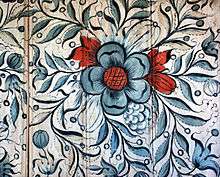
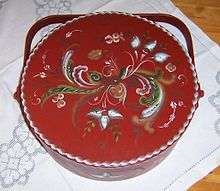
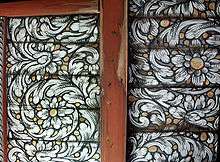
Etymology
Norwegian for "decorative painting", (applied decoration or embellishment, decorative, decorated [rosut, rosute, rosete, rosa] and "å måle, å male" to paint). "Rose" can be interpreted as a reference to the rose flower, but the floral elements are often so stylized that no specific flower is identifiable, and are absent in some designs.
History in Norway
Rosemåling in Norway originated in the low-land areas of eastern Norway particularly in the Telemark and Hallingdal, but also in Numedal and Setesdal and in other valleys in Vest-Agder, Hordaland, Sogn og Fjordane and Rogaland. It came into existence around 1750, when Baroque and Rococo, artistic styles of the upper class, were introduced into Norway's rural culture.[3]
Rosemåling designs use C and S strokes and feature scroll and flowing lines, floral designs, and both subtle and vibrant colors. Script lettering, scenes, animal and human figures may also be included. Artists who specialized in rosemåling often came from poorer classes in the countryside. They would travel from county to county painting churches, homes and furnishings for a commission of either money or merely room and board. Thus rosemåling was carried over the mountains and toward Norway's western coast. Once farther away from the influence of the painters' guild, these artists tried new ideas and motifs. Rosemåling became widespread as amateur artists in rural areas often imitated this folk art. Soon strong regional styles developed and today the three main styles are Telemark, Hallingdal and Rogaland, named after the regions in which each originated.[4]
Rosemåling is, in a sense, the two-dimensional counterpart of acanthus carving, since it is clear that the C and S curves in rosemåling take their inspiration from the acanthus carvings of Baroque and Rococo art and the acanthus carvings in the rural churches (e.g., the altar reredoses and pulpits) and homes (e.g., cupboards) were painted in the same bright colors as used in rosemåling. While in the cities these acanthus carvings were generally gilt, the rural artisans did not have ready access to gold leaf as their urban counterparts and so painted their carvings in the bright colors popular in rural communities (e.g., Norwegian rural dress, Cf. bunad). Like rosemåling, acanthus carving has had a cultural revival in recent times as both a means of interior design (e.g., on furniture, picture frames, door and window frames, etc.) and as a personal hobby, although most modern day acanthus carving is left unpainted and unvarnished.
An anecdote about the Nazi occupation of Norway (1940–1945) is that at a time when the public display of the Norwegian flag or the State Coat of Arms could bring imprisonment or even death, the Norwegians discovered that they could display the 'H' overlapping the '7' of the Royal cypher of their exiled king, Haakon VII, at the center of a rosemåling design without the German occupation forces seeing anything but a colorful peasant design. Christmas cards with the Royal cypher at the center of a rosemåling design were especially popular; many have survived and their history documented.
History in Sweden
Rosemåling is also common in rural Sweden (Swedish: rosmålning) where it is also[5] called kurbitsmålning[6] or simply kurbits, where kurbits refers to depictions of Cucurbita. As with its Norwegian counterpart, it was most popular from the latter half of the 18th century[7] and until the 1860s.[3]
History in America
Norwegian immigrants brought the art of Rosemåling to the United States since many of the immigrants came from parts of Norway where rosemåling was well established. They often carried their belongings in beautifully painted trunks. Some of the immigrants were Rosemåling painters. This generation, however, contributed little to the development of American rosemåling in the 20th century, because rosemåling began to go out of style starting in 1860.[8]
Rosemåling experienced its revival in America in the 20th century. Norwegian-Americans became interested in the rosemåling decorated possessions of their ancestors. American rosemåling began to develop and flourish. The revival of Rosemåling in the United States is often credited to Per Lysne who was born in Norway and trained in the craft. He came to America in the early 20th century and was employed as a wagon painter in Stoughton, Wisconsin. When business slowed during the Great Depression, he began Rosemåling again. Today Norwegian rosemåling is taught in many areas of the USA. Rosemåling associations sponsor classes and competitions.[9][10]
Gallery
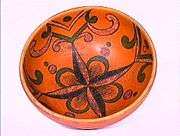 Norsk Folkemuseum in Oslo
Norsk Folkemuseum in Oslo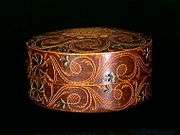 Norsk Folkemuseum in Oslo
Norsk Folkemuseum in Oslo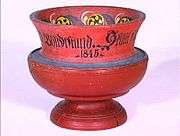 Norsk Folkemuseum in Oslo
Norsk Folkemuseum in Oslo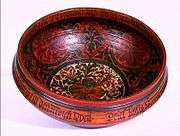 Norsk Folkemuseum in Oslo
Norsk Folkemuseum in Oslo
References
- Likheter och Olikheter page 17. Retrieved 2010
- Folk Art and Folklore in Sweden (Dala/Art) Retrieved 2010-04-06
- "History of Rosemaling". Illinois Norsk Rosemalers Association. Archived from the original on 5 March 2014. Retrieved 5 March 2014.
- History of Rosemaling (Velkommen til rosemalingens hjemmeside)
- Likheter och Olikheter page 17. Retrieved 2010
- Folk Art and Folklore in Sweden (Dala/Art) Retrieved 2010-04-06
- Swedish kurbits paintings (Swedish Dala Paintings) Retrieved 2010-04-06
- The Norwegian Art of Rosemaling (Sons of Norway Atlanta Lodge) Archived 2013-12-20 at the Wayback Machine
- The art of rosemaling, Per Lysne (Recollection Wisconsin)
- History of Rosemaling (Rosemaling by Christina)
Other sources
- Blanck, Helen Elizabeth (1975) Rosemaling : the beautiful Norwegian art (Saint Paul, MN: Woodland Park Fine Arts) ISBN 978-1932043082
- Edwards, Diane (1994) Design basics for Telemark rosemaling (Alamosa, CO: Diane Edwards and W.B. Brown) ISBN 978-1463734756
- Edwards, Sybil (1994) Decorative folk art: exciting techniques to transform everyday objects (London: David & Charles) ISBN 978-0715307847
- Ellingsgard, Nils (1993) Norwegian rose painting in America : what the immigrants brought (Oslo: Aschehoug AS) ISBN 978-8200218616
- Martin, Philip (1989) Rosemaling in the Upper Midwest : a story of region & revival (Mount Horeb, Wis: Wisconsin Folk Museum) ISBN 978-0962436901
- Miller, Margaret M.; Sigmund Aarseth (1974) Norwegian rosemaling : decorative painting on wood (New York City: Scribners) ISBN 978-0684167435
Related Reading
- Bergan, Donna; Linda Alexander (1985) Rosemaling patterns for Christmas tree ornaments / contribution from American rosemalers (Vesterheim Norwegian-American Museum)
- Oram, Gayle M. (2001) Rosemaling Styles and Study, Volume 2 (Vesterheim Norwegian-American Museum)
External links
| Wikimedia Commons has media related to Rosemaling. |
| Look up rosemaling in Wiktionary, the free dictionary. |